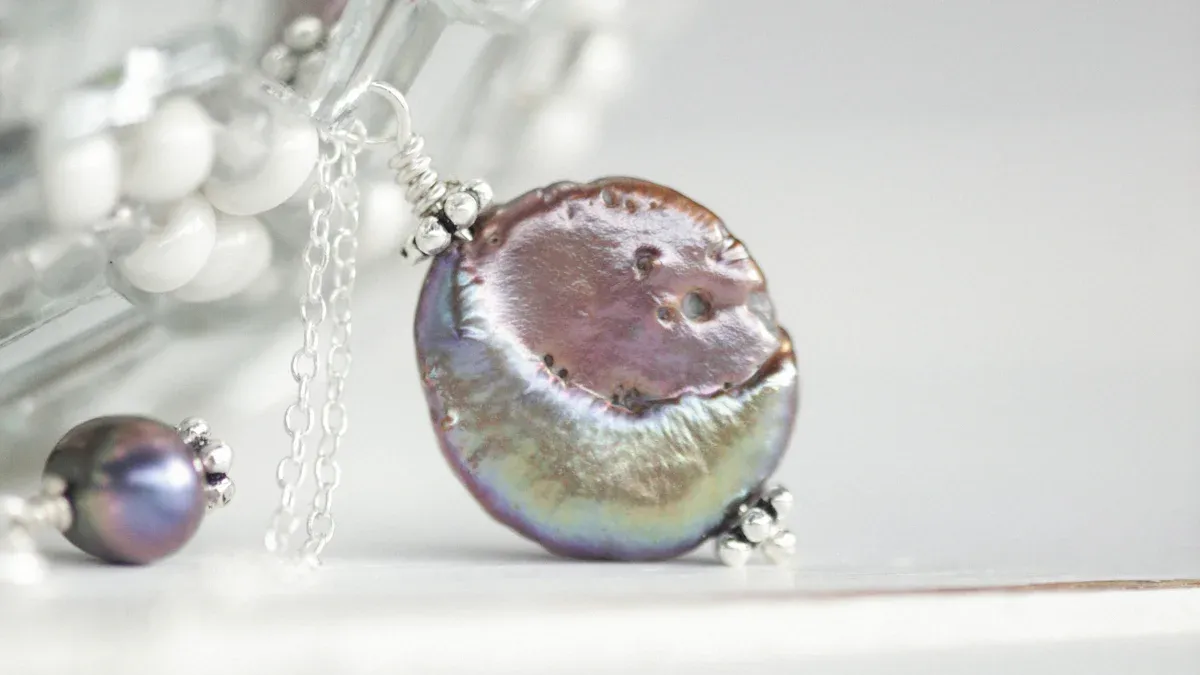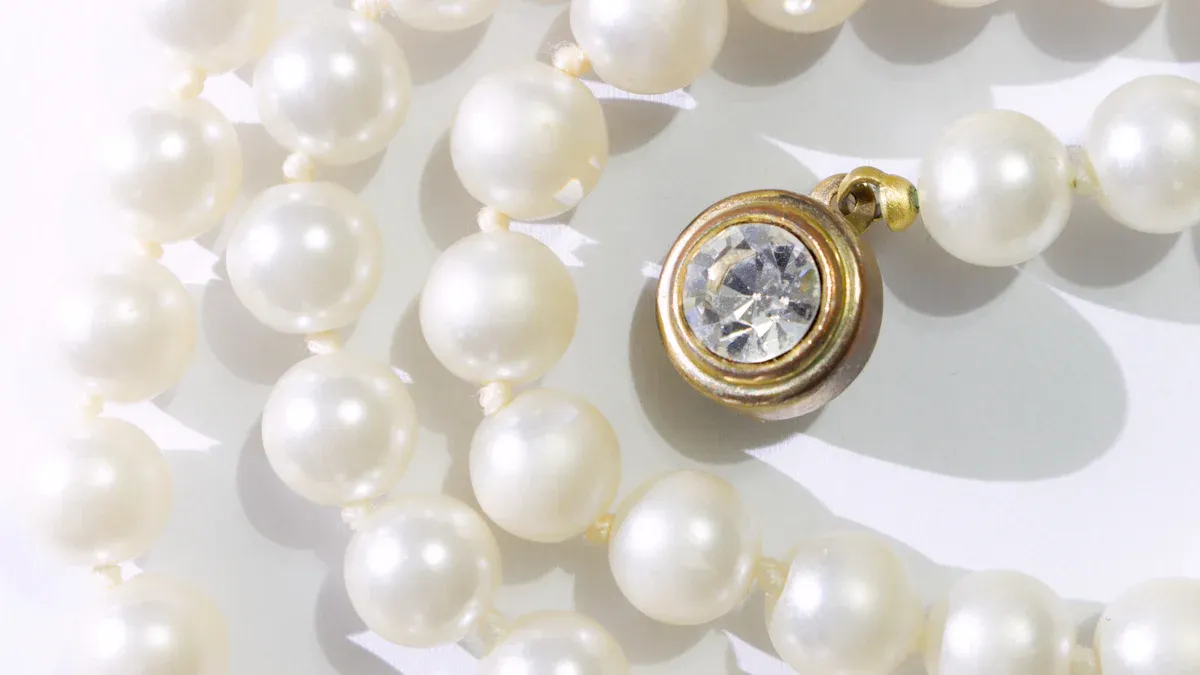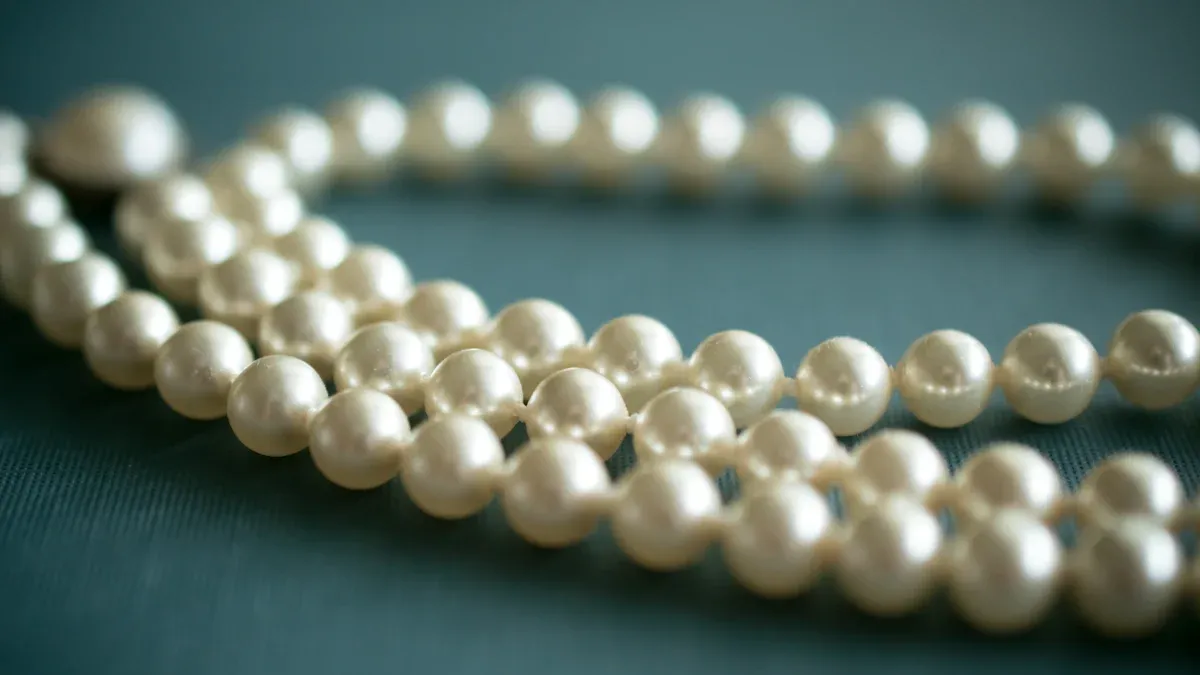
Baroque pearls stand out for their irregular shapes and natural beauty. Unlike traditional round pearls, these gems embrace individuality. You might wonder, what are baroque pearls? They are pearls formed when nature shapes them in unexpected ways, resulting in unique forms. These imperfections make each baroque pearl one-of-a-kind. Their distinctive luster and texture add to their charm, making them a favorite for jewelry lovers. If you value originality, baroque pearls offer a perfect way to express your style.
Key Takeaways
Baroque pearls are special because of their uneven shapes and flaws. Each pearl is unique and different from others.
Their shiny surface and mixed textures make jewelry look interesting. This allows people to show creativity and stand out.
Baroque pearls usually cost less than round pearls. This makes them a good choice for those who like unique jewelry.
When picking baroque pearls, look at their texture and shine. These features make them beautiful and valuable.
Enjoy the beauty of flaws with baroque pearls. They show realness and add personal style to your jewelry.
What Are Baroque Pearls?
Definition and Formation
Baroque pearls are pearls with irregular shapes that form naturally inside mollusks. Unlike perfectly round pearls, these gems develop unique forms due to the way they grow. You might wonder how this process works. When an irritant, such as a grain of sand or a parasite, enters the mollusk, it triggers a natural defense mechanism. The mollusk begins to coat the irritant with layers of nacre, a shiny substance made of calcium carbonate. Over time, these layers build up, creating a pearl.
The formation of baroque pearls depends on several factors:
The mollusk's biological response to the irritant.
The environment in which the mollusk lives, including water temperature and quality.
The shape and position of the irritant inside the mollusk.
This process often results in pearls with non-symmetrical shapes, ranging from teardrops to abstract forms. Baroque pearls can grow in both freshwater and saltwater environments, making them versatile and widely available.
How They Differ from Traditional Pearls
Baroque pearls stand out from traditional pearls in several ways. While traditional pearls are prized for their round, symmetrical shapes, baroque pearls embrace imperfection. Their irregular forms make them unique and visually striking. You’ll notice that baroque pearls often have a more textured surface compared to the smooth finish of traditional pearls. This texture adds depth and character to their appearance.
Another key difference lies in their luster. Baroque pearls reflect light in a way that highlights their curves and angles, creating a dynamic shimmer. Traditional pearls, on the other hand, have a uniform glow. Additionally, baroque pearls come in a wider variety of shapes, such as coin, drop, and Keshi pearls. These shapes give you more options when choosing jewelry that suits your personal style.
Baroque pearls also tend to be more affordable than perfectly round pearls. Their unique beauty and accessibility make them a popular choice for those who appreciate individuality in their jewelry.
Unique Characteristics of Baroque Pearls

Irregular Shapes and Forms
Baroque pearls are celebrated for their irregular shapes, which make them stand out from traditional pearls. These shapes can range from teardrops and ovals to completely abstract forms. No two baroque pearls look exactly alike, giving each one a unique identity. When you wear jewelry made from these pearls, you carry a piece of nature's artistry that cannot be replicated.
The irregular forms of baroque pearls often inspire creativity in jewelry design. Jewelers use their distinctive shapes to craft bold and unconventional pieces. For example, a drop-shaped baroque pearl might become the centerpiece of a pendant, while a coin-shaped pearl could add elegance to a bracelet. These pearls allow you to express your individuality through your choice of accessories.
Luster and Surface Texture
The luster of baroque pearls is another feature that sets them apart. Unlike traditional pearls, which reflect light evenly, baroque pearls have a dynamic shimmer. Their curves and angles catch light in unexpected ways, creating a play of colors that adds depth and intrigue. This unique luster enhances their natural beauty and makes them a favorite among pearl enthusiasts.
The surface texture of baroque pearls varies widely. Some pearls are almost smooth, while others have noticeable ridges or grooves. These textures contribute to their charm and individuality. To better understand the quality of baroque pearls based on their surface texture, consider the following grading system:
Quality Grade |
Description |
|---|---|
A |
Entirely smooth; minor imperfections hidden by drill holes. |
B |
Lightly blemished; minor imperfections cover less than a third of the surface. |
C |
Moderately blemished; light imperfections cover less than two-thirds of the surface. |
D |
Heavily blemished; light imperfections cover more than two-thirds of the surface. |
When selecting baroque pearls, you can use this grading system to evaluate their quality. Higher-grade pearls tend to have smoother surfaces, while lower-grade pearls may show more imperfections. However, even heavily blemished pearls possess a unique charm that appeals to many.
The Beauty of Imperfections
Baroque pearls remind you that beauty lies in imperfection. Their irregular shapes and textured surfaces tell a story of natural growth and transformation. These imperfections make each pearl one-of-a-kind, offering a sense of authenticity that perfectly round pearls cannot match.
When you choose baroque pearls, you embrace the idea that flaws can be beautiful. This perspective resonates with many people, as it reflects the imperfections we all carry. Baroque pearls symbolize individuality and self-expression, making them a meaningful addition to your jewelry collection.
Their imperfections also make them versatile. You can pair them with casual outfits for a relaxed look or use them to add character to formal attire. Baroque pearls prove that beauty comes in many forms, encouraging you to celebrate your unique style.
How to Identify Genuine Baroque Pearls
Key Features of Authentic Baroque Pearls
When identifying genuine baroque pearls, focus on their unique characteristics. Authentic baroque pearls have irregular shapes, often resembling teardrops, ovals, or abstract forms. Their luster is dynamic, reflecting light in a way that highlights their curves and angles. This shimmer creates a play of colors, adding depth to their appearance.
Examine the surface texture closely. Genuine baroque pearls may have ridges, grooves, or slight blemishes, which enhance their natural charm. These imperfections are a hallmark of authenticity. Additionally, baroque pearls feel cool to the touch and warm up when held, a trait that distinguishes them from imitations.
Tips for Spotting Imitations
Imitation pearls often lack the unique features of genuine baroque pearls. To spot fakes, start by inspecting the surface. Fake pearls usually have a uniform, plastic-like finish, while real baroque pearls display natural textures and irregularities.
Perform a simple "tooth test." Gently rub the pearl against your teeth. Genuine pearls feel gritty due to their nacre layers, whereas imitations feel smooth. You can also check the weight. Real pearls are heavier than their synthetic counterparts.
Pay attention to the price. If a deal seems too good to be true, it probably is. Baroque pearls are more affordable than traditional pearls, but genuine ones still hold value.
Importance of Certification and Trusted Sources
Always purchase baroque pearls from reputable jewelers or trusted sources. Certification from a recognized gemological institute ensures authenticity. This document provides details about the pearl's origin, quality, and type.
Avoid buying pearls from unknown sellers or unverified online platforms. Trusted sources often provide guarantees and return policies, giving you peace of mind. By choosing certified pearls, you ensure that your investment is genuine and of high quality.
Remember, understanding what are baroque pearls and their unique traits helps you make informed decisions when purchasing these beautiful gems.
Types of Baroque Pearls
Coin Pearls
Coin pearls are flat, round pearls that resemble the shape of a coin. Their unique form comes from the way they grow against a flat surface inside the mollusk. These pearls often have a smooth surface and a brilliant luster, making them a popular choice for jewelry. You’ll notice that coin pearls are lightweight, which makes them comfortable to wear in earrings, necklaces, or bracelets.
One of the most appealing features of coin pearls is their versatility. Their flat shape allows jewelers to create modern and minimalist designs. For example, a single coin pearl can serve as a striking pendant, or multiple pearls can form a statement necklace. If you prefer a sleek and contemporary look, coin pearls are an excellent option.
Tip: When choosing coin pearls, look for ones with a high luster and minimal blemishes. These qualities enhance their beauty and value.
Drop Pearls
Drop pearls have a teardrop shape that gives them an elegant and timeless appearance. Their elongated form makes them ideal for creating sophisticated jewelry pieces, such as pendants or dangling earrings. You’ll often see drop pearls used in bridal jewelry due to their classic and graceful look.
These pearls vary in size and proportion, ranging from perfectly symmetrical drops to more abstract shapes. This variety allows you to find a style that matches your personal taste. Drop pearls also reflect light beautifully, highlighting their curves and adding a touch of glamour to any outfit.
Fun Fact: Drop pearls symbolize purity and elegance, making them a meaningful gift for special occasions.
Keshi Pearls
Keshi pearls are entirely made of nacre, which gives them an exceptional luster. Unlike other pearls, Keshi pearls form without a nucleus, resulting in irregular shapes and sizes. Their organic appearance makes them a favorite among those who appreciate natural beauty.
You’ll find Keshi pearls in a wide range of colors, from classic white to exotic shades like silver, gold, and even lavender. Their unique shapes inspire creativity in jewelry design. For instance, Keshi pearls are often used in artistic and unconventional pieces that stand out.
Note: Keshi pearls are rare and highly valued for their pure nacre composition. If you’re looking for something truly special, these pearls are worth considering.
Other Notable Varieties
Baroque pearls come in many fascinating forms, each with its own charm. Beyond coin, drop, and Keshi pearls, you’ll find other notable varieties that showcase nature’s creativity.
Potato Pearls: These pearls get their name from their oval, slightly lumpy shape, resembling a potato. They are often used in necklaces and bracelets due to their uniform size and affordability. Their soft luster adds a subtle elegance to casual and formal outfits.
Button Pearls: Shaped like a small, flattened disk, button pearls are ideal for earrings and rings. Their flat base allows them to sit snugly against the skin or a jewelry setting. You’ll appreciate their versatility and understated beauty.
Baroque Akoya Pearls: These pearls are a rare find. Unlike traditional Akoya pearls, which are known for their round shape, baroque Akoya pearls have irregular forms. Their high luster and smooth surface make them a luxurious choice for unique jewelry pieces.
Fireball Pearls: These pearls are large and dramatic, often featuring a metallic sheen. Their name comes from their bold, irregular shapes that resemble a burst of fire. Fireball pearls make a statement in necklaces or pendants, perfect for those who love bold accessories.
Tip: When exploring these varieties, consider how their shapes and sizes fit your personal style. Each type offers something unique, whether it’s the subtle charm of potato pearls or the bold allure of fireball pearls.
These lesser-known baroque pearls highlight the diversity and beauty of nature’s artistry. By choosing one of these varieties, you can add a distinctive touch to your jewelry collection.
The Significance of Baroque Pearls in Jewelry

Historical and Cultural Importance
Baroque pearls have a rich history that reflects their timeless appeal. During the Renaissance and Baroque periods, these pearls symbolized wealth and status. Royalty and nobility adorned themselves with baroque pearl jewelry to showcase their power and sophistication. You can still see these historical pieces in museums, where they highlight the craftsmanship of the time.
In the mid-20th century, baroque pearls experienced a resurgence in popularity. Designers like Verdura and William Ruser embraced their irregular shapes, creating bold and artistic jewelry. These pieces became iconic in the 1950s and 1960s, representing a shift toward individuality in fashion. Today, vintage baroque pearl jewelry remains highly sought after by collectors, preserving their cultural significance.
Modern Trends in Jewelry Design
Baroque pearls continue to inspire modern jewelry designers. Their unique shapes and textures allow for creative and unconventional designs. You’ll notice that many contemporary pieces feature baroque pearls as statement elements. Designers often pair them with mixed metals, gemstones, or minimalist settings to create striking contrasts.
Recent trends show a growing appreciation for vintage baroque jewelry. Collectors and fashion enthusiasts value these pieces for their history and artistry. While new baroque pearl jewelry is less common, the demand for vintage designs highlights their enduring charm. This trend reflects a broader movement toward sustainable and timeless fashion choices.
-
Key modern trends include:
Incorporating baroque pearls into asymmetrical earrings.
Using them as focal points in layered necklaces.
Combining them with bold, geometric shapes for a contemporary look.
Timeless Appeal and Versatility
Baroque pearls stand out for their ability to complement any style. Their irregular shapes and dynamic luster make them versatile enough for both casual and formal occasions. You can wear a simple baroque pearl pendant with a casual outfit or choose a dramatic necklace for an elegant evening look.
Their imperfections add character, making each piece unique. This individuality resonates with those who value personal expression in their accessories. Baroque pearls also pair well with various materials, such as gold, silver, or leather, enhancing their adaptability.
Tip: When styling baroque pearls, let their natural beauty shine. Choose designs that highlight their unique shapes and textures for a truly timeless look.
Baroque pearls remind you that beauty lies in individuality. Their historical significance, modern appeal, and versatility make them a cherished choice for jewelry lovers around the world.
Baroque pearls celebrate individuality through their irregular shapes and natural imperfections. Their unique luster and textures make them a standout choice for jewelry lovers like you. These pearls encourage you to embrace the beauty of nature’s artistry and express your personal style.
Baroque pearls remind you that imperfections can be beautiful. Their timeless appeal and versatility inspire creativity, making them a meaningful addition to any jewelry collection.
Let these pearls be a reflection of your unique charm and appreciation for natural beauty.
FAQ
What makes baroque pearls different from other pearls?
Baroque pearls stand out due to their irregular shapes and unique textures. Unlike traditional round pearls, they embrace natural imperfections, offering one-of-a-kind designs. Their dynamic luster and variety of forms make them a favorite for creative jewelry pieces.
Are baroque pearls real pearls?
Yes, baroque pearls are genuine pearls. They form naturally inside mollusks, just like traditional pearls. Their irregular shapes result from the way they grow, making them authentic and unique.
How should you care for baroque pearl jewelry?
To care for baroque pearls, clean them gently with a soft cloth after wearing. Avoid exposing them to harsh chemicals, perfumes, or extreme temperatures. Store them separately in a soft pouch to prevent scratches.
Tip: Wear your pearls often! Natural oils from your skin help maintain their luster.
Are baroque pearls valuable?
Baroque pearls are valuable, but their price depends on factors like size, luster, and quality. While they are often more affordable than perfectly round pearls, rare varieties like Keshi or Fireball pearls can command higher prices.
Can you wear baroque pearls every day?
Yes, you can wear baroque pearls daily. Their versatility makes them suitable for casual and formal outfits. Just ensure proper care to maintain their beauty over time.
Fun Fact: Baroque pearls symbolize individuality, making them a meaningful choice for everyday wear.

